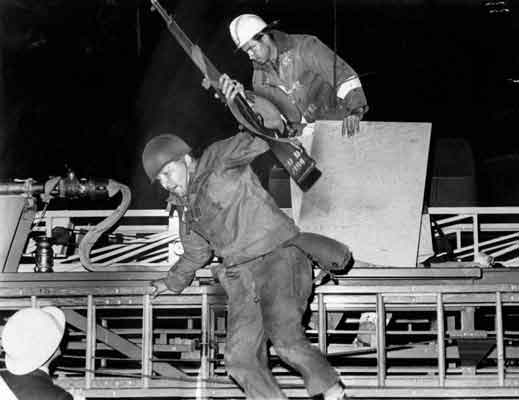Riots in Watts -1965

Nartional Guard in Watts
Five days of riots broke out on August 11, 1965 in the Watts section of Los Angeles. The riots caused 34 deaths and injuries to 1,000 people. Over 4,000 individuals were arrested. Property damage was estimated at $40 million. The riots in Watts were the most severe of a series of riots that took place in many American cities in the mid-1960s.
The Watts Riots, also known as the Watts Rebellion, erupted on August 11, 1965, in the Watts neighborhood of Los Angeles, California. The riots were one of the most severe and devastating urban uprisings of the 1960s, reflecting deep racial tensions, economic disparities, and frustrations within the African American community.
The immediate trigger for the riots occurred on the evening of August 11, when Marquette Frye, a 21-year-old African American man, was pulled over by a white California Highway Patrol officer for suspected drunk driving. The situation quickly escalated as a crowd gathered, tensions flared, and rumors spread that the police were using excessive force. Frye's mother, who had come to the scene, became involved, and soon, the altercation spiraled out of control. The growing crowd, already on edge due to the strained relations between the police and the Black community, erupted in anger.
By the next day, what began as a relatively isolated incident had exploded into a full-scale riot that would last for five days. The streets of Watts were filled with thousands of rioters, and the unrest quickly spread to neighboring areas. The rioters, predominantly African American, targeted white-owned businesses, government buildings, and vehicles. Buildings were set on fire, stores were looted, and the police struggled to contain the chaos.
The intensity of the violence was unprecedented at the time. The Los Angeles Police Department (LAPD), overwhelmed by the scale of the uprising, called in reinforcements, including the California National Guard. The National Guard deployed thousands of troops to Watts and other affected areas to restore order. Despite these efforts, the violence continued for days, with rioters and law enforcement clashing in the streets.
The toll of the riots was staggering. By the time the violence was brought under control on August 17, 34 people had been killed, many of them African Americans. Over 1,000 people were injured, including both civilians and law enforcement officers. The riots resulted in more than 4,000 arrests, and the property damage was estimated at around $40 million (equivalent to over $330 million today). Entire blocks of buildings were reduced to rubble, and many businesses never recovered from the destruction.
The Watts Riots were not an isolated incident but part of a broader pattern of urban unrest that swept across American cities during the 1960s. The underlying causes of the riots were complex and deeply rooted in systemic issues. African Americans in Watts, as in many other urban areas, faced pervasive poverty, unemployment, inadequate housing, and discrimination in nearly every aspect of life. The riots were a manifestation of the frustrations and anger that had been simmering for years within the Black community.
The riots also exposed the deep racial divide in America and the inadequacies of the government's response to the civil rights movement. While the passage of the Civil Rights Act of 1964 and the Voting Rights Act of 1965 were significant milestones, they did not address the economic and social inequalities that continued to plague African Americans. The Watts Riots were a stark reminder that the fight for civil rights was far from over and that addressing the root causes of racial unrest required more than just legal reforms.
In the aftermath of the riots, various government agencies and community organizations attempted to address the issues that had fueled the unrest. However, progress was slow, and many of the problems that had led to the Watts Riots persisted for decades. The riots left a lasting impact on Los Angeles and the nation, serving as a wake-up call for the need to confront racial inequality and social injustice in a meaningful way. The Watts Riots remain a pivotal moment in American history, symbolizing the deep-seated racial tensions that have shaped the nation's past and continue to influence its present.
.
 >
>